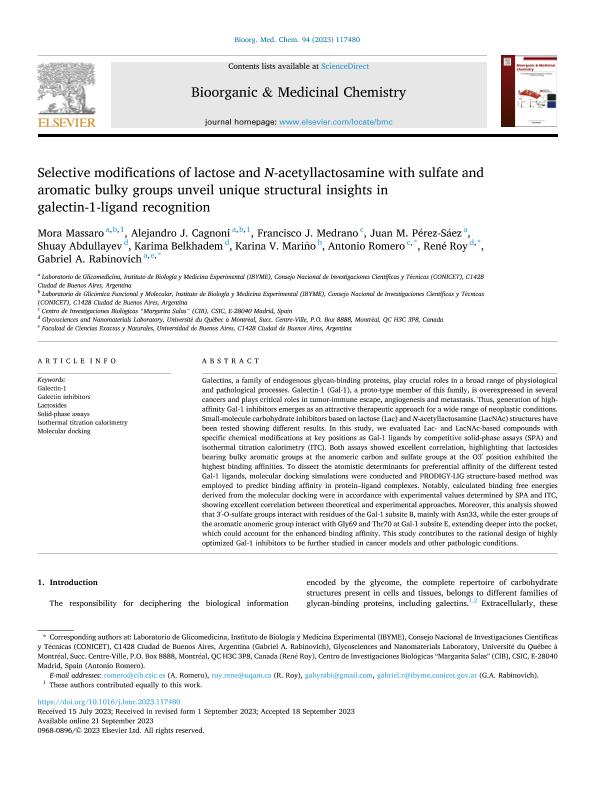Artículo
Selective modifications of lactose and N-acetyllactosamine with sulfate and aromatic bulky groups unveil unique structural insights in galectin-1-ligand recognition
Massaro, Mora ; Cagnoni, Alejandro
; Cagnoni, Alejandro ; Medrano, Francisco J.; Pérez Sáez, Juan Manuel
; Medrano, Francisco J.; Pérez Sáez, Juan Manuel ; Abdullayev, Shuay; Belkhadem, Karima; Mariño, Karina Valeria
; Abdullayev, Shuay; Belkhadem, Karima; Mariño, Karina Valeria ; Romero, Antonio; Roy, René; Rabinovich, Gabriel Adrián
; Romero, Antonio; Roy, René; Rabinovich, Gabriel Adrián
 ; Cagnoni, Alejandro
; Cagnoni, Alejandro ; Medrano, Francisco J.; Pérez Sáez, Juan Manuel
; Medrano, Francisco J.; Pérez Sáez, Juan Manuel ; Abdullayev, Shuay; Belkhadem, Karima; Mariño, Karina Valeria
; Abdullayev, Shuay; Belkhadem, Karima; Mariño, Karina Valeria ; Romero, Antonio; Roy, René; Rabinovich, Gabriel Adrián
; Romero, Antonio; Roy, René; Rabinovich, Gabriel Adrián
Fecha de publicación:
10/2023
Editorial:
Pergamon-Elsevier Science Ltd
Revista:
Bioorganic and Medicinal Chemistry
ISSN:
0968-0896
e-ISSN:
1464-3391
Idioma:
Inglés
Tipo de recurso:
Artículo publicado
Clasificación temática:
Resumen
Galectins, a family of endogenous glycan-binding proteins, play crucial roles in a broad range of physiological and pathological processes. Galectin-1 (Gal-1), a proto-type member of this family, is overexpressed in several cancers and plays critical roles in tumor-immune escape, angiogenesis and metastasis. Thus, generation of high-affinity Gal-1 inhibitors emerges as an attractive therapeutic approach for a wide range of neoplastic conditions. Small-molecule carbohydrate inhibitors based on lactose (Lac) and N-acetyllactosamine (LacNAc) structures have been tested showing different results. In this study, we evaluated Lac- and LacNAc-based compounds with specific chemical modifications at key positions as Gal-1 ligands by competitive solid-phase assays (SPA) and isothermal titration calorimetry (ITC). Both assays showed excellent correlation, highlighting that lactosides bearing bulky aromatic groups at the anomeric carbon and sulfate groups at the O3′ position exhibited the highest binding affinities. To dissect the atomistic determinants for preferential affinity of the different tested Gal-1 ligands, molecular docking simulations were conducted and PRODIGY-LIG structure-based method was employed to predict binding affinity in protein–ligand complexes. Notably, calculated binding free energies derived from the molecular docking were in accordance with experimental values determined by SPA and ITC, showing excellent correlation between theoretical and experimental approaches. Moreover, this analysis showed that 3′-O-sulfate groups interact with residues of the Gal-1 subsite B, mainly with Asn33, while the ester groups of the aromatic anomeric group interact with Gly69 and Thr70 at Gal-1 subsite E, extending deeper into the pocket, which could account for the enhanced binding affinity. This study contributes to the rational design of highly optimized Gal-1 inhibitors to be further studied in cancer models and other pathologic conditions.
Archivos asociados
Licencia
Identificadores
Colecciones
Articulos(IBYME)
Articulos de INST.DE BIOLOGIA Y MEDICINA EXPERIMENTAL (I)
Articulos de INST.DE BIOLOGIA Y MEDICINA EXPERIMENTAL (I)
Citación
Massaro, Mora; Cagnoni, Alejandro; Medrano, Francisco J.; Pérez Sáez, Juan Manuel; Abdullayev, Shuay; et al.; Selective modifications of lactose and N-acetyllactosamine with sulfate and aromatic bulky groups unveil unique structural insights in galectin-1-ligand recognition; Pergamon-Elsevier Science Ltd; Bioorganic and Medicinal Chemistry; 94; 10-2023; 1-10
Compartir
Altmétricas



